8.2E: Exercises
- Page ID
- 120498
\( \newcommand{\vecs}[1]{\overset { \scriptstyle \rightharpoonup} {\mathbf{#1}} } \)
\( \newcommand{\vecd}[1]{\overset{-\!-\!\rightharpoonup}{\vphantom{a}\smash {#1}}} \)
\( \newcommand{\id}{\mathrm{id}}\) \( \newcommand{\Span}{\mathrm{span}}\)
( \newcommand{\kernel}{\mathrm{null}\,}\) \( \newcommand{\range}{\mathrm{range}\,}\)
\( \newcommand{\RealPart}{\mathrm{Re}}\) \( \newcommand{\ImaginaryPart}{\mathrm{Im}}\)
\( \newcommand{\Argument}{\mathrm{Arg}}\) \( \newcommand{\norm}[1]{\| #1 \|}\)
\( \newcommand{\inner}[2]{\langle #1, #2 \rangle}\)
\( \newcommand{\Span}{\mathrm{span}}\)
\( \newcommand{\id}{\mathrm{id}}\)
\( \newcommand{\Span}{\mathrm{span}}\)
\( \newcommand{\kernel}{\mathrm{null}\,}\)
\( \newcommand{\range}{\mathrm{range}\,}\)
\( \newcommand{\RealPart}{\mathrm{Re}}\)
\( \newcommand{\ImaginaryPart}{\mathrm{Im}}\)
\( \newcommand{\Argument}{\mathrm{Arg}}\)
\( \newcommand{\norm}[1]{\| #1 \|}\)
\( \newcommand{\inner}[2]{\langle #1, #2 \rangle}\)
\( \newcommand{\Span}{\mathrm{span}}\) \( \newcommand{\AA}{\unicode[.8,0]{x212B}}\)
\( \newcommand{\vectorA}[1]{\vec{#1}} % arrow\)
\( \newcommand{\vectorAt}[1]{\vec{\text{#1}}} % arrow\)
\( \newcommand{\vectorB}[1]{\overset { \scriptstyle \rightharpoonup} {\mathbf{#1}} } \)
\( \newcommand{\vectorC}[1]{\textbf{#1}} \)
\( \newcommand{\vectorD}[1]{\overrightarrow{#1}} \)
\( \newcommand{\vectorDt}[1]{\overrightarrow{\text{#1}}} \)
\( \newcommand{\vectE}[1]{\overset{-\!-\!\rightharpoonup}{\vphantom{a}\smash{\mathbf {#1}}}} \)
\( \newcommand{\vecs}[1]{\overset { \scriptstyle \rightharpoonup} {\mathbf{#1}} } \)
\( \newcommand{\vecd}[1]{\overset{-\!-\!\rightharpoonup}{\vphantom{a}\smash {#1}}} \)
Exercises
In Exercises 1 - 6, find the standard equation of the circle and then graph it.
- Center \((-1, -5)\), radius \(10\)
- Center \((4,-2)\), radius \(3\)
- Center \(\left(-3, \frac{7}{13}\right)\), radius \(\frac{1}{2}\)
- Center \((5, -9)\), radius \(\ln(8)\)
- Center \(\left(-e, \sqrt{2}\right)\), radius \(\pi\)
- Center \((\pi, e^{2})\), radius \(\sqrt[3]{91}\)
In Exercises 7 - 12, complete the square in order to put the equation into standard form. Identify the center and the radius or explain why the equation does not represent a circle.
- \(x^{2} - 4x + y^{2} + 10y = -25\)
- \(-2x^{2} - 36x - 2y^{2} - 112 = 0\)
- \(x^2+y^2+8x-10y -1 =0\)
- \(x^2+y^2+5x-y-1=0\)
- \(4x^{2} + 4y^{2} - 24y + 36 = 0\)
- \(x^{2} + x + y^{2} - \frac{6}{5}y = 1\)
In Exercises 13 - 16, find the standard equation of the circle which satisfies the given criteria.
- center \((3, 5)\), passes through \((-1, -2)\)
- center \((3, 6)\), passes through \((-1, 4)\)
- endpoints of a diameter: \((3,6)\) and \((-1,4)\)
- endpoints of a diameter: \(\left( \frac{1}{2}, 4\right)\), \(\left(\frac{3}{2}, -1\right)\)
- The Giant Wheel at Cedar Point is a circle with diameter 128 feet which sits on an 8 foot tall platform making its overall height is 136 feet.2 Find an equation for the wheel assuming that its center lies on the \(y\)-axis and that the ground is the \(x\)-axis.
- Verify that the following points lie on the Unit Circle: \((\pm 1, 0)\), \((0, \pm 1)\), \(\left(\pm \frac{\sqrt{2}}{2}, \pm \frac{\sqrt{2}}{2}\right)\), \(\left(\pm \frac{1}{2}, \pm \frac{\sqrt{3}}{2}\right)\) and \(\left(\pm \frac{\sqrt{3}}{2}, \pm \frac{1}{2}\right)\)
- Discuss with your classmates how to obtain the standard equation of a circle from the equation of the Unit Circle, \(x^2+y^2=1\) using the transformations discussed in Section 1.7. (Thus every circle is just a few transformations away from the Unit Circle.)
- Find an equation for the function represented graphically by the top half of the Unit Circle. Explain how the transformations is Section 1.7 can be used to produce a function whose graph is either the top or bottom of an arbitrary circle.
- Find a one-to-one function whose graph is half of a circle. (Hint: Think piecewise.)
Answers
- \((x + 1)^{2} + (y + 5)^{2} = 100\)

- \((x-4)^2+(y+2)^2 = 9\)
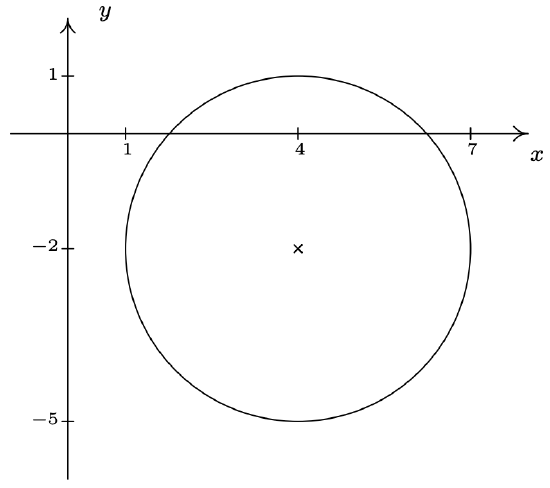
- \(\left(x + 3\right)^{2} + \left(y - \frac{7}{13}\right)^{2} = \frac{1}{4}\)
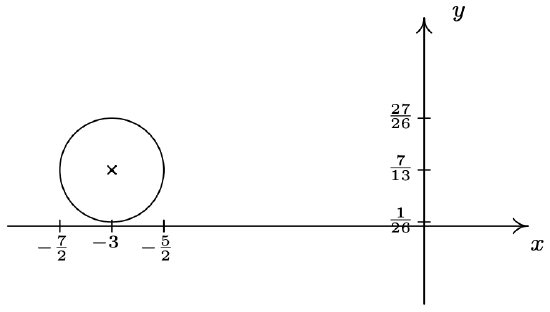
- \((x - 5)^{2} + (y + 9)^{2} = (\ln(8))^{2}\)
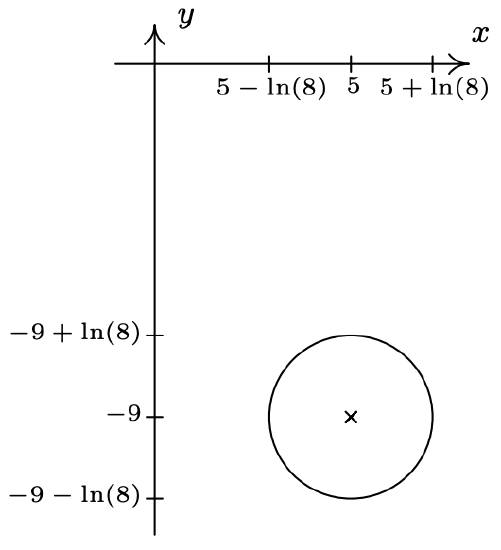
- \((x + e)^{2} + \left(y - \sqrt{2} \right)^{2} = \pi^{2}\)
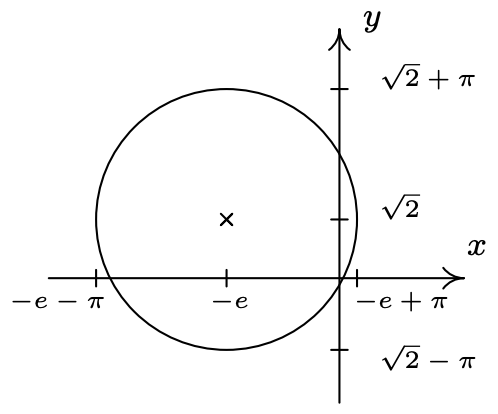
- \(\left(x - \pi \right)^{2} + \left(y - e^{2}\right)^{2} = 91^{\frac{2}{3}}\)
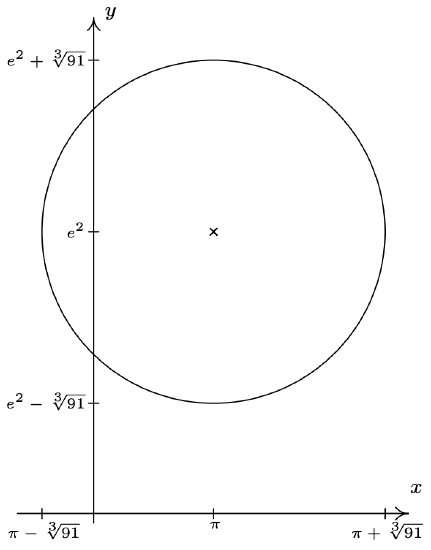
-
\((x - 2)^{2} + (y + 5)^{2} = 4\)
Center \((2, -5)\), radius \(r = 2\) -
\((x + 9)^{2} + y^{2} = 25\)
Center \((-9, 0)\), radius \(r = 5\) -
\((x+4)^2 + (y-5)^2 = 42\)
Center \((-4,5)\), radius \(r = \sqrt{42}\) -
\(\left(x + \frac{5}{2}\right)^2 + \left(y - \frac{1}{2}\right)^2 = \frac{30}{4}\)
Center \(\left( -\frac{5}{2}, \frac{1}{2}\right)\), radius \(r = \frac{\sqrt{30}}{2}\) -
\(x^{2} + (y - 3)^{2} = 0\)
This is not a circle. -
\(\left(x + \frac{1}{2}\right)^{2} + \left(y - \frac{3}{5}\right)^{2} = \frac{161}{100}\)
Center \(\left(-\frac{1}{2}, \frac{3}{5}\right)\), radius \(r = \frac{\sqrt{161}}{10}\) - \((x - 3)^{2} + (y - 5)^{2} = 65\)
- \((x-3)^2+(y-6)^2 = 20\)
- \((x-1)^2 + (y-5)^2 = 5\)
- \((x-1)^2 + \left(y - \frac{3}{2}\right)^2 = \frac{13}{2}\)
- \(x^{2} + (y - 72)^{2} = 4096\)

